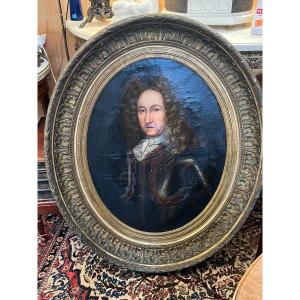Considered one of the most beautiful women of the 17th century, it's only natural that Hortense Mancini should be portrayed as Venus. Like a goddess filled with eros, the young woman emerges from a dark background, her shirt drooping, her shoulder bare and her breast uncovered. Thus, our portrait presents Cardinal Mazarin's favorite niece scrutinizing the viewer who dares to gaze upon her bosom. The composition fully embraces the style of Flemish painter Jacob Ferdinand Voet; Hortense's gaze is arresting and her expression evocative, the drapery is supple and particular care is given to the rendering of fabrics.
This portrait was probably painted during Hortense's stay in exile in Rome after 1668, a period during which Jacob Ferdinand Voet painted portraits of numerous patricians of the Eternal City, including the Mazarinettes, Cardinal Mazarin's nieces and Hortense's sisters.
While our painting was in the collection of Captain Arthur Christie Crawford of Cartburn, a descendant of a line of Scottish barons (handwritten notes from the period and a label stuck to the back of the stretcher attest to this), a second, very similar portrait (see photo) was sold in London in 2019 for £62,500. It is not surprising that these two paintings were kept in the United Kingdom: the beautiful and sultry Hortense lived there, was the mistress of King Charles II and died there. She was elevated to the status of icon of women's emancipation.
This delightful painting is presented in a 17th-century French frame in carved and gilded wood.
Sizes : 72 x 59 cm – 91 x 78 cm with the frame.
Sold with invoice and certificate.
Hortense Mancini (Rome 06.06.1646 - Chelsea 02 July 1699) was one of eight siblings, including the famous Marie, who was loved by Louis XIV. Daughter of the Roman baron Michele Mancini and niece of Cardinal Mazarin, she was brought up at the French court by her uncle. Hortense was one of the most beautiful women of her time, and one powerful suitor after another asked for her hand in marriage; the future King of England Charles II and then the Duke of Savoy Charles-Emmanuel II were turned down by the cardinal. And when she was just 15 years old, her uncle decided to marry Armand-Charles de La Porte, Duc de La Meilleraye. When the Cardinal died in 1661, Hortense and Armand-Charles took the titles of Duke and Duchess of Mazarin and moved into the sumptuous Mazarin palace near the Louvre. After giving birth to four children, Hortense tired of her husband's devotion, which tended towards madness, and decided to free herself from this union, which she considered to be an "odious slavery". Leaving her children behind, she set off on a long journey across Europe. She first settled in Rome with her family, then in Chambéry under the protection of the Duke of Savoy. It was during this stay in Savoy that she wrote and published her memoirs, making her the first woman in the kingdom to publish her memoirs during her lifetime. In 1675, on the death of Charles-Emmanuel II, his escape ended in England at the court of the joyous monarch Charles II. The man once spurned by Cardinal Mazarin now reigned over the British Isles, and took the beautiful Hortense, then aged 29, as his favorite mistress. A literate, freedom-loving woman, she introduced the French salon tradition to England, presiding over a gathering of the most prominent intellectuals and literary figures of the period.
Biography :
Jacob Ferdinand Voet (Antwerp 1639 - Paris 26.09.1689) was the son of painter Elias Voet. From 1663 to 1679, he lived in Rome, where he enjoyed a great reputation, painting portraits of members of patrician families such as Colonna, Odescalchi, Chigi and Mancini. Over the next few years, he travelled to Milan, Florence and Turin, stopping off in his native Antwerp in 1684. The following year, he moved to Paris, where he settled permanently and became a court painter.
Dutch biographer Arnold Houbraken (1660 - 1719) states that Voet painted both history and landscapes, but curiously none of these compositions are known to us, only his elegant portraits bear witness to his art. His works can be admired in major museums: London's National Portrait Gallery, Amsterdam's Rijksmuseum, the Musée du Louvre in Paris and the Hermitage Museum in St. Petersburg, to name but a few.
Bibliography :


























 Le Magazine de PROANTIC
Le Magazine de PROANTIC TRÉSORS Magazine
TRÉSORS Magazine Rivista Artiquariato
Rivista Artiquariato
